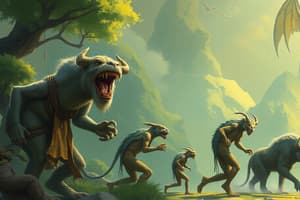Podcast
Questions and Answers
Which of the following best describes Darwin's concept of adaptation in the context of evolution?
Which of the following best describes Darwin's concept of adaptation in the context of evolution?
- The sudden and drastic changes in an organism's DNA, leading to immediate survival advantages.
- The development of identical characteristics among different species sharing the same habitat.
- The process by which organisms acquire traits needed to survive, irrespective of environmental changes.
- The gradual change in characteristics of a species over time in response to environmental requirements. (correct)
According to Darwin's theory, what role does natural selection play in the evolution of species?
According to Darwin's theory, what role does natural selection play in the evolution of species?
- It promotes the evolution of species towards a predetermined and ideal form.
- It ensures that all adaptations contribute to progressive evolution and improved traits.
- It favors the transmission of acquired characteristics during an organism's lifetime to its offspring.
- It leads to the selection of superior changes that enhance survival and the elimination of inferior ones. (correct)
How does Darwin's concept of common ancestry relate to the diversity of life on Earth?
How does Darwin's concept of common ancestry relate to the diversity of life on Earth?
- It suggests all organisms evolved independently and simultaneously, converging on similar traits.
- It argues that species are fixed and immutable, with no connections between different groups of organisms.
- It proposes that all life forms share a single, ancient ancestor from which they have diverged over time. (correct)
- It implies that more complex organisms spontaneously arise from simpler ones continuously.
Darwin's observation of Galapagos finches with different beak types is an example of what evolutionary process?
Darwin's observation of Galapagos finches with different beak types is an example of what evolutionary process?
According to Darwin, what is the typical timescale for significant evolutionary change?
According to Darwin, what is the typical timescale for significant evolutionary change?
Which of the following is NOT a key component of natural selection, as described in the content?
Which of the following is NOT a key component of natural selection, as described in the content?
How does inheritance contribute to the process of natural selection and evolution?
How does inheritance contribute to the process of natural selection and evolution?
What is the relationship between a high rate of population growth and natural selection?
What is the relationship between a high rate of population growth and natural selection?
How do 'superior' variations contribute to natural selection, according to Darwin's theory?
How do 'superior' variations contribute to natural selection, according to Darwin's theory?
What is the ultimate outcome of differential survival and reproduction in the context of natural selection?
What is the ultimate outcome of differential survival and reproduction in the context of natural selection?
Flashcards
Adaptation
Adaptation
The process where species evolve and change over time, adapting to new environmental demands.
Natural Selection
Natural Selection
Only the advantageous changes in an organism are naturally selected, while less beneficial ones are eliminated.
Common Ancestry
Common Ancestry
The theory that all organisms share ancestors, and evolve from a common origin, diverging over time.
Adaptive Radiation
Adaptive Radiation
Signup and view all the flashcards
Gradual Evolution
Gradual Evolution
Signup and view all the flashcards
Variation
Variation
Signup and view all the flashcards
Inheritance
Inheritance
Signup and view all the flashcards
High Rate of Population Growth
High Rate of Population Growth
Signup and view all the flashcards
Differential Survival
Differential Survival
Signup and view all the flashcards
Study Notes
- Species evolve and change over time, adapting to new environmental requirements.
- Adaptation is the phenomenon of changing over time according to natural requirements.
- Only superior changes are naturally selected, while inferior ones are eliminated.
- Not all adaptations contribute to progressive evolution.
- Organisms share common ancestry, diverging from a single ancestor over time.
- Darwin's evolutionary theories support convergent and divergent evolution.
- Darwin's finches on the Galapagos Islands developed different beaks based on food availability, demonstrating adaptive radiation.
- Australian Marsupials also showed marsupials emerging from an ancestor.
- Evolution is a gradual process that takes place over billions of years.
- The generation of a new species from another is a slow and steady process.
- Natural selection occurs in four ways
Variation
- Changes accumulate over time, potentially leading to a new species.
Inheritance
- Variations are passed on over generations, leading to speciation.
Population Growth
- Species reproduce more organisms than the environment can support.
Differential survival and reproduction
- Superior variations lead to survival, while inferior variations lead to extinction.
- Superior variations are inherited during reproduction.
Studying That Suits You
Use AI to generate personalized quizzes and flashcards to suit your learning preferences.
Description
Explore species evolution, adaptation to environmental needs, and natural selection favoring superior changes. Discover common ancestry, Darwin's theories, and examples like Galapagos finches and Australian marsupials. Understand evolution as a gradual process leading to new species through inherited variations.




